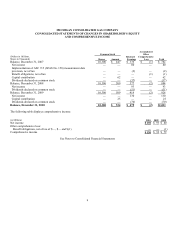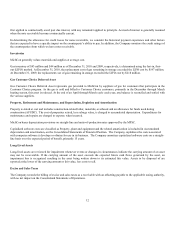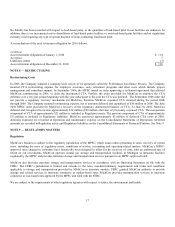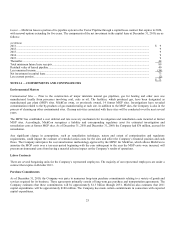DTE Energy 2010 Annual Report Download - page 21
Download and view the complete annual report
Please find page 21 of the 2010 DTE Energy annual report below. You can navigate through the pages in the report by either clicking on the pages listed below, or by using the keyword search tool below to find specific information within the annual report.19
• Deferred income taxes — Michigan Business Tax (MBT) - In July 2007, the MBT was enacted by the State of Michigan. State
deferred tax liabilities were established and offsetting regulatory assets were recorded as the impacts of the deferred tax liabilities
will be reflected in rates as the related taxable temporary differences reverse and flow through current income tax expense. (1)
• Deferred environmental costs — The MPSC approved the deferral of investigation and remediation costs associated with former
MGP sites. Amortization of deferred costs is over a ten-year period beginning in the year after costs were incurred, with recovery
(net of any insurance proceeds) through base rate filings.
• Unamortized loss on reacquired debt — The unamortized discount, premium and expense related to debt redeemed with a
refinancing are deferred, amortized and recovered over the life of the replacement issue.
• Cost to achieve Performance Excellence Process (PEP) — The MPSC authorized the deferral of costs to implement the PEP.
These costs consist of employee severance, project management and consultant support. These costs are amortized over a ten-year
period beginning with the year subsequent to the year the costs were deferred.
(1) Regulatory assets not earning a return.
LIABILITIES
• Asset removal costs — The amount collected from customers for the funding of future asset removal activities.
• Negative pension offset — The Company’ s negative pension costs are not included as a reduction to its authorized rates; therefore,
the Company is accruing a regulatory liability to eliminate the impact on earnings of the negative pension expense accrued. This
regulatory liability will reverse to the extent the Company’ s pension expense is positive in future years.
• Refundable income taxes — Income taxes refundable to our customers representing the difference in property-related deferred
income taxes payable and amounts recognized pursuant to MPSC authorization.
• Deferred income taxes — Michigan Business Tax — In July 2007, the MBT was enacted by the State of Michigan. State deferred
tax assets were established, and offsetting regulatory liabilities were recorded as the impacts of the deferred tax assets will be
reflected in rates.
• Refundable self implemented rates — Amounts refundable to customers for base rates implemented by MichCon in excess of
amounts authorized in MPSC orders.
• Accrued GCR refund — Liability for the temporary over-recovery of and a return on gas costs incurred by MichCon which are
recoverable through the GCR mechanism.
2010 Gas Rate Case Filing
MichCon filed a rate case on July 27, 2010 based on a fully projected 2011 test year. The filing with the MPSC requested a
$51 million increase in revenues. During the pendency of this proceeding, MichCon continuously evaluated its case and determined
that it no longer desired to pursue the relief requested. On December 13, 2010, the MPSC approved MichCon’ s request to withdraw
this rate filing.
2009 Gas Rate Case Filing
On June 3, 2010, the MPSC issued an order in MichCon’ s June 9, 2009 rate case filing. The MPSC approved an annual revenue
increase of $119 million. Included in the approved increase in revenues was a return on equity of 11% on an expected permanent
capital structure of 50.4% equity and 49.6% debt. The rate order includes a $22 million impact of lower depreciation rates as ordered
by the MPSC in March 2010, effective April 1, 2010. Since the final rate relief ordered was less than the Company’ s self-implemented
























